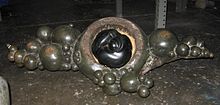Tapfuma Gutsa

Tapfuma Gutsa (born 1956) is a Zimbabwean sculptor.[1][2][3]
A native of Harare, Gutsa studied sculpture with Cornelius Manguma at the Driefontein Mission School,[4] later becoming the first Zimbabwean recipient of a British Council award.[5] The scholarship allowed him to study in London from 1982 until 1985, where he received a diploma in sculpture from the City and Guilds of London School of Art.[6][7]
Gutsa is unusual among Zimbabwean stone sculptors for the breadth of materials he uses in his work; his sculptures incorporate metal, paper, wood, and other foreign materials.[8][9][10] His winning sculpture at the Nedlaw exhibition, 1987, comprised smouldering grass engulfing a wooden bird.[11] He is the cousin of Dominic Benhura, who studied with him; he has also been a mentor to many young artists including Fabian Madamombe.
In 2007, Gutsa was one of eleven international artists commissioned by the Victoria and Albert Museum, London, to produce work for an exhibition titled 'Uncomfortable Truths: The Shadow of Slave Trading on Contemporary Art'.[12][13]
Awards
- 1987 Nedlaw award for sculpture, National Gallery of Zimbabwe[11]
References
- ^ Mawdsley, Joceline (1994). Zimbabwe stone sculpture: the second generation. Harare, Zimbabwe: Chapungu Sculpture Park.
- ^ Stanislaus, Grace (1992). "Frozen spirit: Zimbabwean stone sculpture". Sculpture. 11 (1). Washington, DC: 44–47.
- ^ Sultan, Olivier (1992). Life in stone: Zimbabwean sculpture; birth of a contemporary art form. Harare, Zimbabwe: Baobab Books.
- ^ Marunya, Kundai (9 January 2015). "Meet Visual Artist, Tapfuma Gutsa". Harare News. Retrieved 19 November 2018.
- ^ Appiah, Anthony; Gates, Henry Louis (2010). Encyclopedia of Africa, Volume 2. Oxford University Press. p. 545. ISBN 9780195337709. Retrieved 19 November 2018.
- ^ Winter-Irving, Celia (1991). Stone sculpture in Zimbabwe: context, content and form. Harare: Roblaw Publishers.
- ^ Morton, Elizabeth (2013). "Patron and Artist in Zimbabwean Art". In Salami, Gitti; Visona, Monica Blackmun (eds.). A Companion to Modern African Art (Blackwell Companions to Art History). John Wiley & Sons. pp. 248–251. ISBN 9781444338379.
- ^ Contemporary art in Zimbabwe. Amsterdam: Artoteek Amsterdam Zuidoost. 1998.
- ^ Cousins, Jane (1991). "The making of Zimbabwean sculpture". Third text; Third World perspectives on contemporary art and culture (13): 31–42.
- ^ Chikukwa, Raphael (2005). Visions of Zimbabwe. Manchester: Manchester Art Gallery.
- ^ a b Zimbabwe heritage 1987. Harare, Zimbabwe: National Gallery of Zimbabwe. 1987.
- ^ Whitley, Zoe (2007). "'Uncomfortable Truths', installation by various artists". Victoria and Albert Museum. Retrieved 19 November 2018.
- ^ Guchu, Wonder (5 June 2007). "Zimbabwe: Gutsa in Slave Trade Exhibition". Zimbabwe Herald. Harare. Retrieved 19 November 2018.
External links
